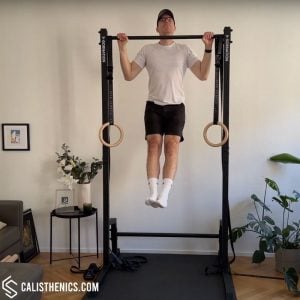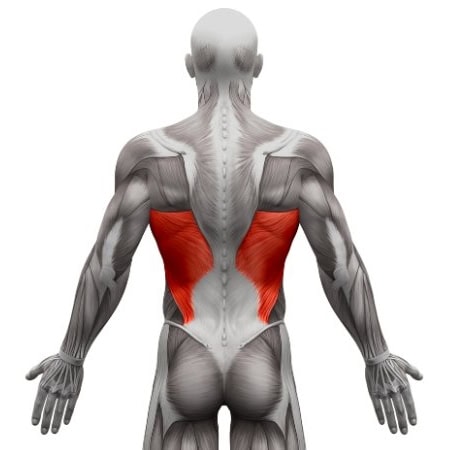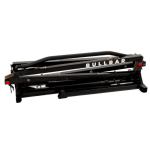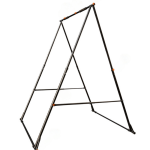Strict Pull-Up
How to do Strict Pull-Up?
The strict pull-up is a fundamental bodyweight exercise that builds upper body strength, grip endurance, and core stability. Performed on a pull-up bar with a shoulder-width overhand grip (palms facing away), the strict pull-up requires full-body control and strict form—no kipping, swinging, or momentum. This movement primarily targets the latissimus dorsi (lats), biceps, and upper back, making it a key exercise for overall pulling strength and muscular development.
Before attempting strict pull-ups, an athlete should have basic scapular control, grip strength, and core stability. Being able to hold a dead hang for at least 30 seconds, perform scapular pull-ups, and complete negative pull-ups with control are good indicators of readiness. Shoulder and wrist mobility are also important for maintaining proper mechanics throughout the movement.
To perform strict pull-ups, you’ll need a pull-up bar with enough clearance for full arm extension at the bottom and chin clearance at the top. Optional equipment includes chalk for improved grip, resistance bands for assistance, and weighted vests or dip belts for additional resistance.
How to Perform the Strict Pull-Up
1. Setup
• Stand under a stable pull-up bar and grip it with a shoulder-width overhand grip (palms facing away from you).
• Your arms should be fully extended, and your shoulders should be slightly engaged (not in a passive dead hang).
• Tighten your core and glutes to prevent swinging and maintain full-body control.
2. The Pulling Phase
• Initiate the movement by engaging your lats and pulling your chest toward the bar.
• Drive your elbows down and back, keeping them close to your body.
• Continue pulling until your chin clears the bar or your upper chest touches the bar if possible.
• Focus on a strong contraction in the lats and upper back at the top of the movement.
3. The Lowering (Eccentric) Phase
• Slowly extend your arms to lower yourself in a controlled manner.
• Fully straighten your elbows at the bottom before beginning the next rep.
• Keep your shoulders engaged to maintain tension and avoid passive hanging.
4. Breathing and Repetition Strategy
• Exhale as you pull yourself up.
• Inhale as you lower yourself back to the starting position.
• Perform each rep with strict form, avoiding momentum-based movements.
Benefits of the Strict Pull-Up
• Develops upper body pulling strength – Engages the lats, biceps, and upper back.
• Improves grip endurance – Holding onto the bar strengthens forearms and hand muscles.
• Enhances scapular stability – Reinforces shoulder control, reducing injury risk.
• Transfers well to other exercises – Strength gained in pull-ups improves rows, muscle-ups, and climbing movements.
• Can be scaled for any fitness level – Adjustable for beginners and advanced athletes alike.
• Promotes better posture – Strengthens the back and counteracts rounded shoulders.
Common Mistakes to Avoid
• Using momentum (kipping) – Avoid swinging your legs or relying on momentum to complete the movement.
• Not engaging the shoulders – Always initiate the movement with scapular retraction to prevent shoulder strain.
• Partial reps – Ensure full range of motion, pulling until your chin clears the bar and lowering fully.
• Overarching the lower back – Engage your core and glutes to maintain a stable body position.
• Flaring the elbows – Keep your elbows close to your body to maximize back and arm engagement.
Gym Equivalent Exercises
• Lat Pulldown (Wide-Grip or Close-Grip) – Simulates the pulling motion of the pull-up with adjustable resistance.
• Seated Cable Row (Close-Grip or Wide-Grip) – Engages similar muscle groups while emphasizing scapular control.
• Assisted Pull-Ups (Resistance Band or Machine) – Helps build strength while maintaining proper form.
• Negative (Eccentric) Pull-Ups – Focuses on the lowering phase to build pulling strength.
Tips for the proper execution of Strict Pull-Up
Keep your wrists neutral to avoid unnecessary strain.
Squeeze your glutes and engage your core to maintain body control.
Try a slight pause at the top to increase time under tension and improve muscle engagement.
Start the pulling motion by first engaging your scapulas before bending your arms.
Wrap your thumbs around the bar and use chalk or gloves for better hold.
If struggling with full reps, focus on negative pull-ups to build strength.
Muscles worked when doing Strict Pull-Up
The strict pull-up primarily targets the upper body and core, with different muscles activating in each phase of the movement.
Primary muscles:
•Latissimus dorsi (lats) – The main pulling muscle responsible for the movement.
•Biceps brachii – Assists in elbow flexion.
•Trapezius and rhomboids – Help with scapular retraction and stabilization.
Secondary muscles:
•Forearms and grip muscles – Necessary for holding onto the bar.
• Core muscles (rectus abdominis, transverse abdominis, obliques) – Maintain body alignment and prevent swinging.
•Rear deltoids – Assist in stabilizing the shoulders during the movement.
Primary Muscle(s):
Secondary Muscle(s):
Adjust the difficulty of Strict Pull-Up
The strict pull-up is a highly versatile exercise, suitable for all fitness levels. Beginners can start with assisted variations, focusing on negatives or resistance bands to build strength. As strength improves, athletes can transition to strict bodyweight reps, then progress to weighted pull-ups or advanced variations like archer or one-arm pull-ups. By adjusting grip, tempo, and resistance, the strict pull-up remains an effective tool for progressive strength development.
How to make Strict Pull-Up harder?
How to make Strict Pull-Up easier?
How to make Strict Pull-Up harder?
To make Strict Pull-Up harder:
-
Add a weighted vest or dip belt to increase resistance.
-
Perform slow negatives, lowering over 5-10 seconds per rep.
-
Increase repetition volume to enhance endurance.
-
Incorporate pause reps, holding at the top for 2-3 seconds before lowering.
-
Perform explosive pull-ups, pulling yourself higher until your chest reaches the bar.
-
Try one-arm pull-up progressions, reducing assistance from one arm over time.
How to make Strict Pull-Up easier?
To make Strict Pull-Up easier:
-
Use a resistance band looped around the bar and your foot for assistance.
-
Perform negative pull-ups, focusing on the eccentric (lowering) phase.
-
Start with scapular pull-ups to strengthen the shoulders before progressing to full reps.
-
Reduce range of motion slightly before progressing to full repetitions.






